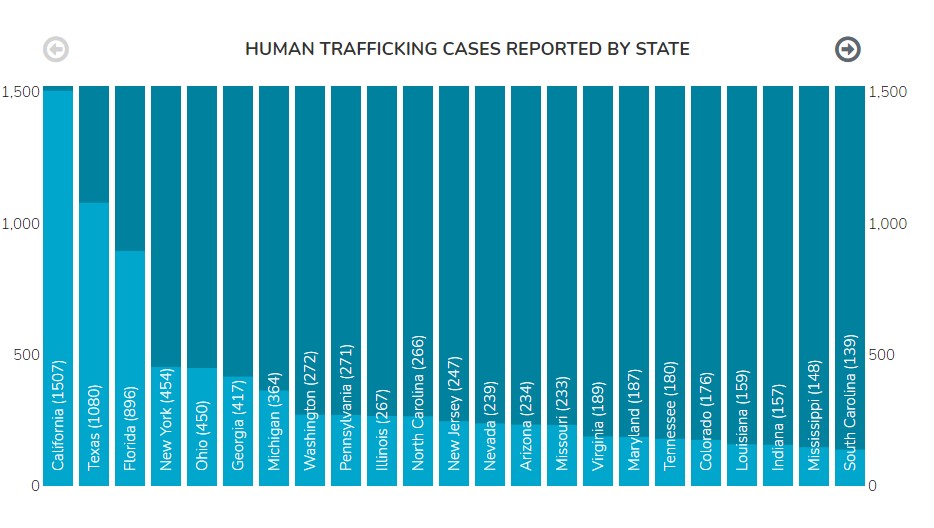Human Trafficking…What is it, Who does it Affect, Where is it Happening
Human trafficking is the recruitment or transportation of a person or persons for the purpose of exploitation, which typically includes fraud, force, or coercion. January is acknowledged as National Slavery and Human Trafficking Prevention Month, and this week, on January 11, we had National Human Trafficking Awareness Day. During this time, many advocates work to expand understanding of trafficking and its impact to our community. Advocates typically wear blue shirts or ribbons and share information about signs and ways to help.
Due to our location, Texas is one of the top states for reported human trafficking. This image below from the National Human Trafficking Hotline/Polaris Project, shows the number of human trafficking cases reported by top states from 2019.

As reported by the U.S. Department of Justice, Houston is one of the largest hubs for human trafficking in the nation. Our access to ports and trading, a major interstate which makes transportation of people easy, and being close to a border, where people can be illegally crossed into the United States and forced to engage in trafficking, create an environment for traffickers. One key note, not all trafficking victims are people who have come from other countries. Many victims come from within our own United States borders.
There are two different types of trafficking we are referring to in this blog: sex and labor trafficking. According to the Polaris Project’s recently published article “data shows that the vast majority of trafficking victims identified in the United States are people who have historically faced discrimination and its political, social and economic consequences: people of color, indigenous communities, immigrants, and people who identify as LGBTQ+ are disproportionately victimized. People living in poverty or foster care, or are struggling with addiction, trauma, abuse or unstable housing, are all at comparatively higher risk for trafficking.” It is important that we are aware of the signs of trafficking and victims “hiding in plain sight”. Below are signs of sex and labor trafficking:
- Living at and being isolated to place of employment
- Working excessively long hours
- Being hesitant to tell you where they live
- Living with large groups of people
- Small children working at places of employment (particularly restaurants)
- Appearing malnourished
- Being branded with tattoos
- Avoiding eye contact or social interaction when with others
- Lacks personal possessions
- Never allowed to be alone
- Having signs of physical injury or abuse
- Does not have personal identification
- Frequent stays at hotels/motels
- Untreated sexually transmitted diseases
- Have a controlling friend or partner
It is important to note that if you ask a trafficking victim if they are being trafficked, the answer will most likely always be “no.” There are typically a lot of threats and violence that are unseen, but fear is a large component of trafficking. Many people develop strong bonds to their traffickers and don’t willingly disclose information.
If you suspect trafficking you can report it to the National Human Trafficking Hotline at 1-888-373-7888 or by text to 233733. They provide free 24/7 confidential services.
If you would like to learn more about trafficking, please check out these resources:
National Human Trafficking Hotline: https://humantraffickinghotline.org/
For resources in specific areas: National Human Trafficking Hotline Referral Directory: https://humantraffickinghotline.org/training-resources/referral-directory
Texas Health and Human Services (has a great video on it!!): https://hhs.texas.gov/services/safety/texas-human-trafficking-resource-center
Office of Human Trafficking and Domestic Violence, City of Houston: https://humantraffickinghouston.org/
United Against Human Trafficking: https://uaht.org/
Written by: Meghan Warner, LCSW-S